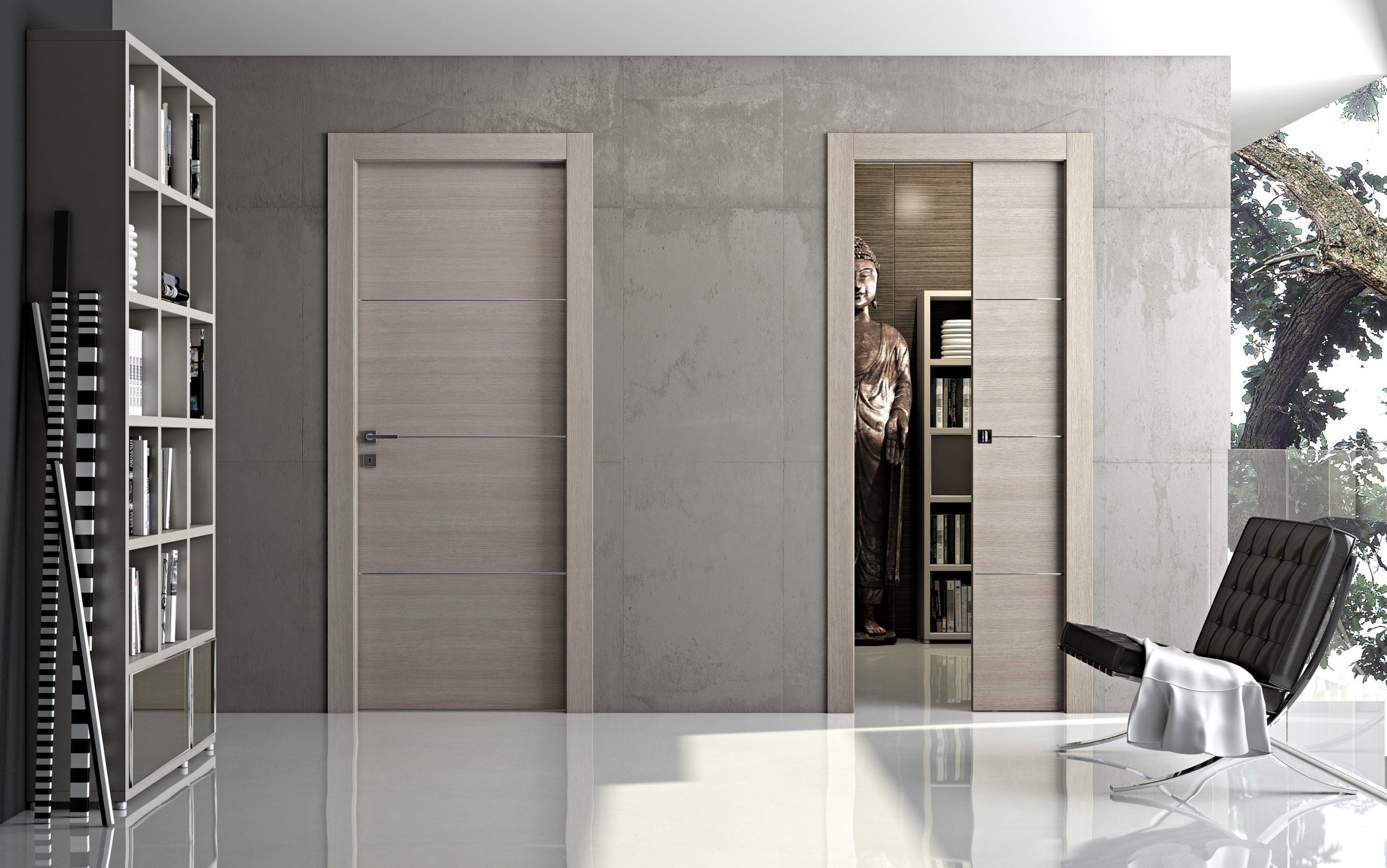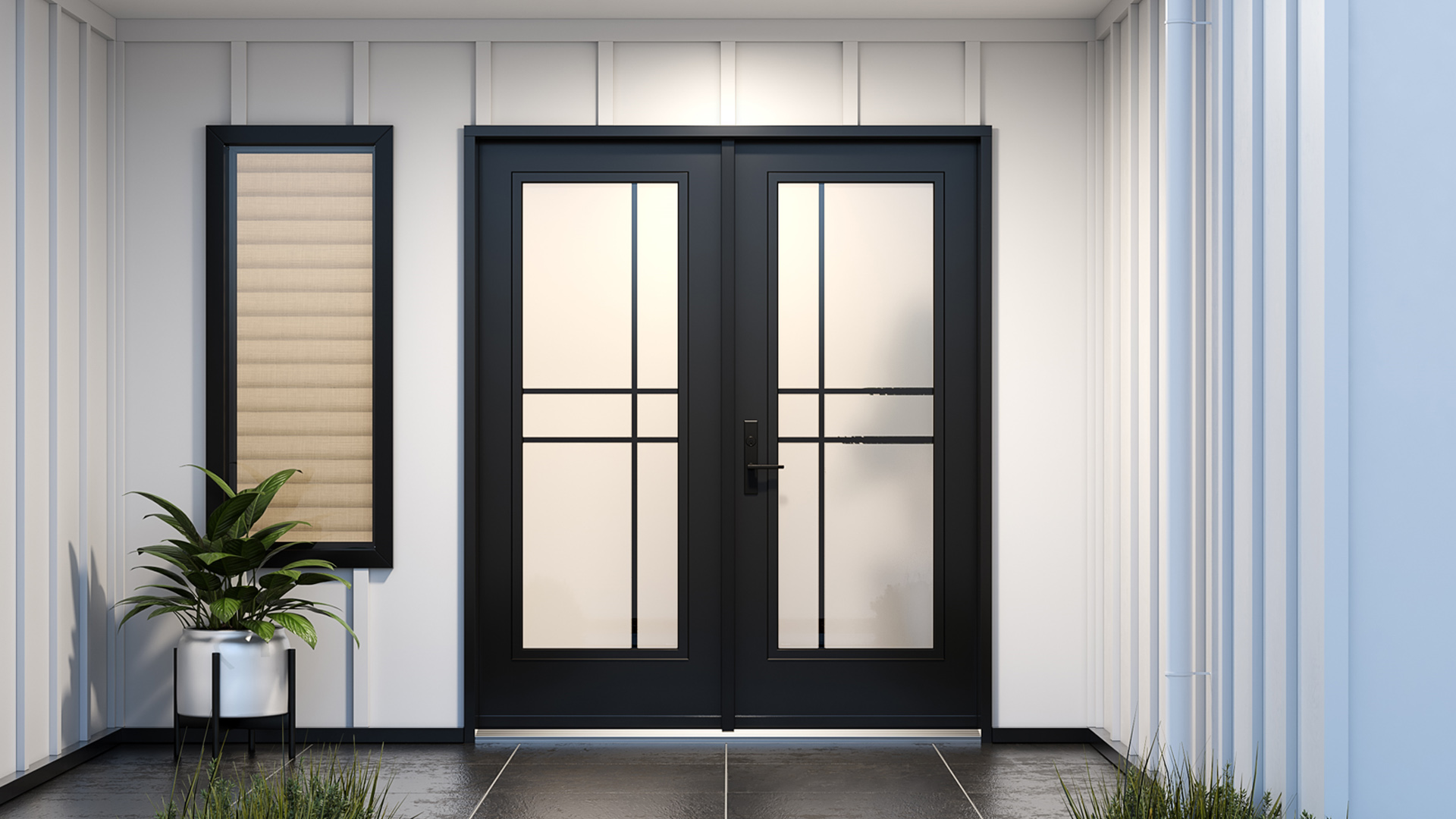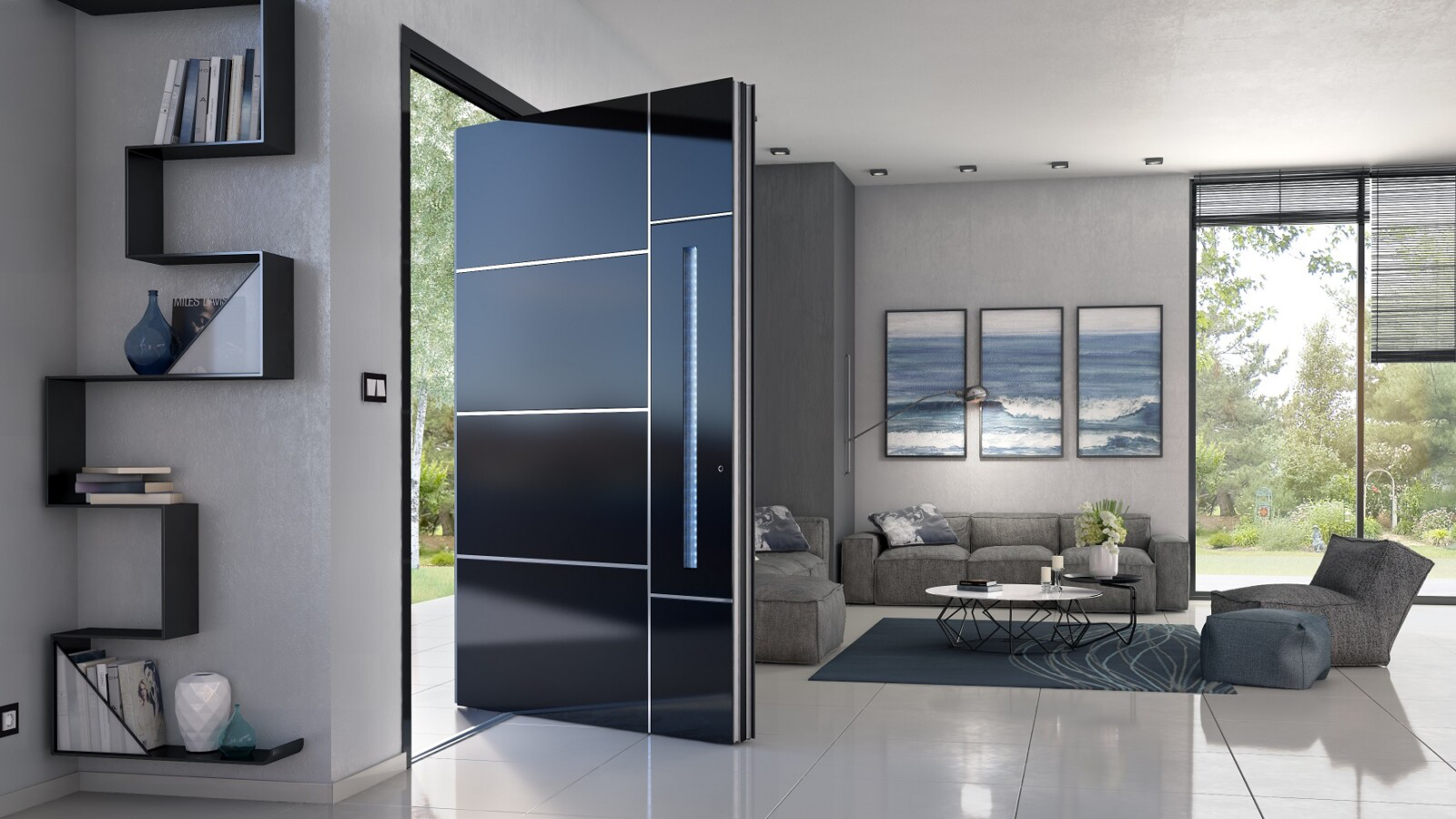What is the best wood for a front entry door?
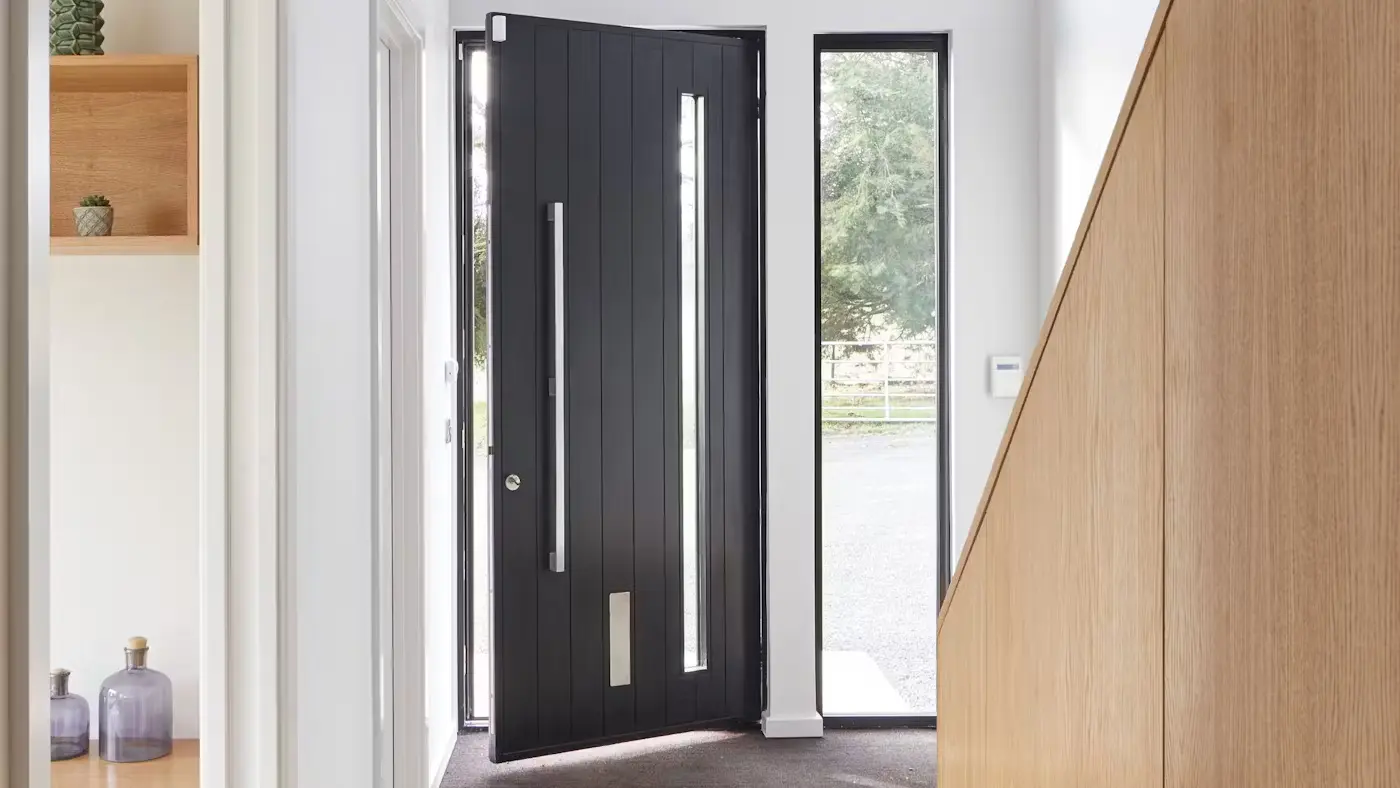
The Importance of Replacing the House Front Door
When selecting a front entry door, one of the most important decisions is choosing the right material, and wood is often the top choice. A well-chosen wooden door not only adds beauty but also offers durability and warmth. In this post, we will explore why the choice of wood matters for your front door and how it influences your home’s overall look and feel.
Why the Choice of Wood Matters for Entry Door?
When it comes to entry doors, wood is a popular and timeless choice. But why does the material matter so much? First and foremost, wood offers unmatched beauty. It has a natural elegance and warmth that other materials like steel or fiberglass can’t replicate. The wood’s grain, color, and texture can add character and charm to any home.
Beyond aesthetics, wood is also a practical choice for a front entry door. It is known for its excellent insulating properties, which help maintain your home’s energy efficiency. A well-insulated wood door can keep the warmth in during winter and the cool air in during summer, making it a functional addition to your home. Furthermore, wood doors provide high security when properly crafted and maintained, ensuring your home remains safe while still looking stylish.
Additionally, the wide variety of wood types, finishes, and designs available means that no matter your personal style or the architectural style of your home, there is a wood door that will complement your needs. Whether you prefer a modern, sleek look or a more rustic, traditional design, the right wood can help you achieve it.
How the Front Door Sets the Tone for Your Home?
Your front entry door is the gateway to your home, and as they say, you only get one chance to make a first impression. The door you choose speaks volumes about your home’s personality. Is it welcoming and warm? Is it modern and sleek? Or is it traditional and sturdy? Your entry door’s materials, color, and design play a crucial role in shaping this first impression.
Wooden entry doors, with their rich textures and natural appeal, immediately convey a sense of elegance and warmth. The door creates an inviting and homely atmosphere when someone steps onto your porch. A wooden door with a polished finish can give your home an upscale look, while a rustic, weathered wooden door can give a charming, lived-in feel.
Furthermore, the front entry door is not just about looks—it’s also about functionality. A sturdy wood door provides a sense of security while enhancing your home’s visual appeal. It’s important to remember that this is the first point of contact for both guests and potential buyers, and investing in a high-quality wood door can raise the overall value of your home. Whether you’re looking to impress guests, create a cozy atmosphere, or increase curb appeal for resale, your front entry door plays an essential role in achieving these goals.
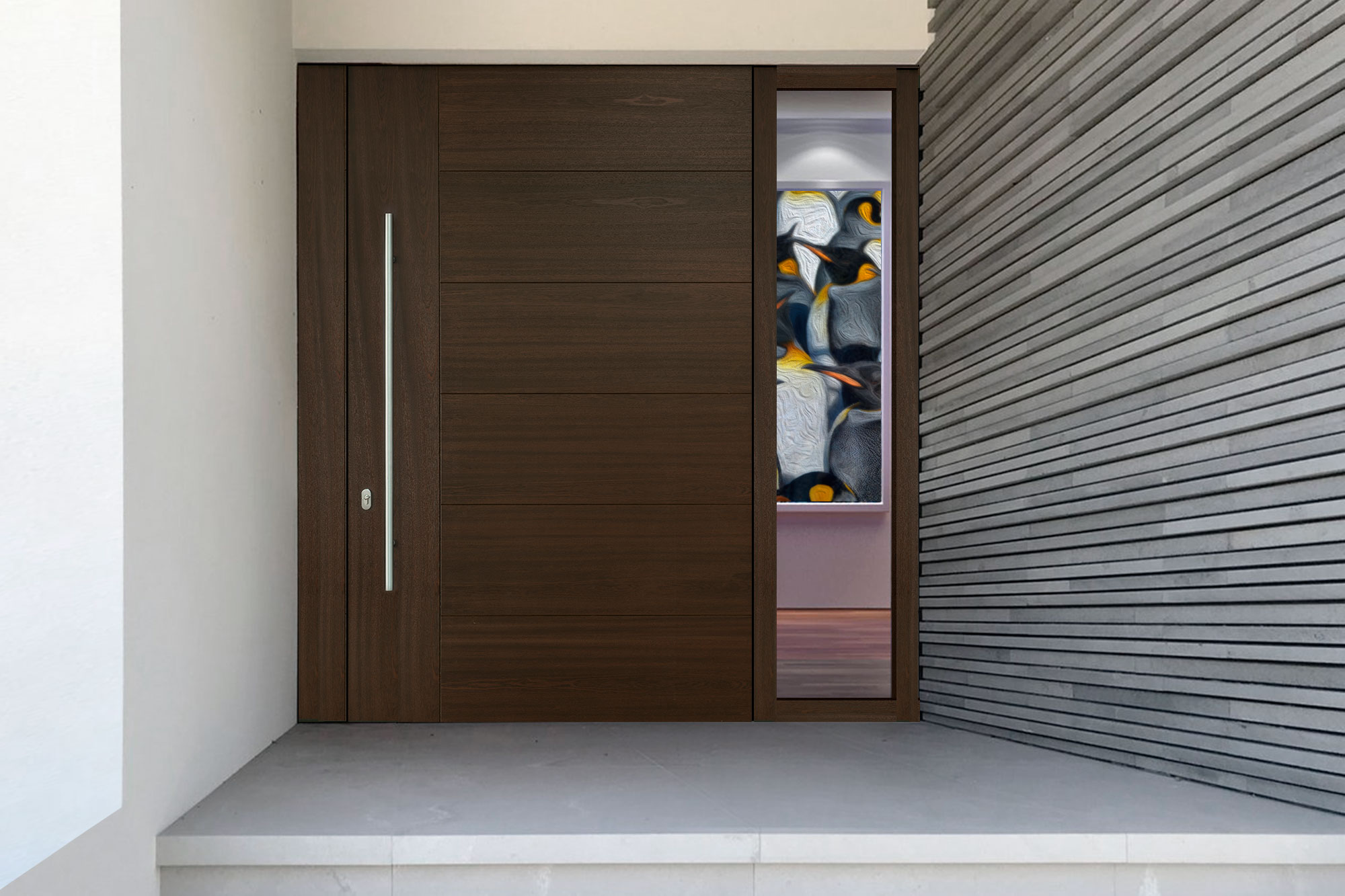
Durability and Weather Resistance
Your front entry door faces the elements daily, so durability and weather resistance are critical when selecting the right wood. Exposure to rain, snow, heat, and cold can cause wear and tear on the door, leading to fading, warping, or cracking over time. Some wood types are naturally more resistant to these effects than others.
Hardwoods like oak, mahogany, and teak are known for their toughness and ability to withstand extreme weather conditions. Mahogany, for instance, is prized for its resistance to moisture and insects, making it an excellent choice for entry doors. On the other hand, softer woods like pine might require more maintenance to keep them in good shape, but they still offer a sturdy option when treated correctly.
In addition to wood type, a proper finish is essential for weather protection. Applying a high-quality sealant or varnish to your wood door can help prevent water damage and UV fading, extending the lifespan of your entry door.
Aesthetic Appeal and Curb Appeal
The aesthetics of your front entry door play a huge role in defining your home’s curb appeal. After all, the door is one of the first things people notice when they visit your home. Choosing the right wood can enhance the visual appeal of your entryway, giving it a sophisticated, warm, or rustic look, depending on your style.
Wood is an incredibly versatile material, offering various colors, grains, and textures. Whether you prefer the sleek, modern appeal of a smooth maple door or the traditional richness of a walnut door, wood can be customized to fit your home’s exterior perfectly. You can also get creative with finishes, such as staining the wood to bring out its natural grain or painting it for a more vibrant look.
Adding decorative elements, like glass panels or custom carvings, can further enhance the door’s visual impact. Remember, the front entry door is not just a functional element; it also reflects your personality and sets the tone for the rest of your home.
Energy Efficiency and Insulation
Energy efficiency is another key consideration when selecting a front entry door. A well-insulated wood door can make a significant difference in the comfort of your home, reducing heating and cooling costs. Wood naturally provides insulation, helping to maintain a consistent indoor temperature by keeping the cold out in the winter and the heat out in the summer.
When choosing a wood for your entry door, additional features that enhance its energy efficiency are also worth considering. Many solid wood doors come with foam cores or other insulating materials that can provide protection. You can also look for doors with weatherstripping or a good-quality seal to prevent drafts from seeping in.
If energy savings are a priority for you, opt for a wood door with excellent insulating properties, like oak or mahogany. Pairing a well-insulated door with proper installation can noticeably impact your home’s energy efficiency.
Factors to Consider When Choosing Wood for a Front Entry Door
Your front entry door is the first impression visitors have of your home, so it’s important to choose one that fits both your style and the overall aesthetic of your property. When selecting the right wood for your entry door, aesthetic and curb appeal are essential considerations. After all, the appearance of your door can elevate the entire look of your home, making it look welcoming, modern, or even timeless, depending on your taste.
Aesthetic Appeal and Curb Appeal
A front entry door is one of the most prominent features of your home’s exterior. It sets the tone for your entire entryway and plays a significant role in creating curb appeal. When choosing a wood entry door, it’s essential to pick a style that complements the architectural design of your house.
A wooden door’s natural look and texture instantly add warmth and elegance to your home’s exterior. Whether you’re aiming for a traditional, rustic, or modern style, wood can provide the versatility to meet those design goals. The natural grains and unique wood features bring character to your entry door, making it a functional and decorative piece. The right wood choice can elevate the overall look of your house, making it stand out in the neighborhood.
Popular Wood Types for Different Architectural Styles
Different architectural styles often call for different types of wood to match their specific characteristics. For example, a rustic farmhouse might benefit from a sturdy oak or pine entry door, which provides a rugged yet timeless look. On the other hand, a more modern or contemporary home might call for a sleek and minimalistic mahogany or walnut door, which has a rich color and smooth finish.
- Traditional Style Homes: Wood types like oak or cherry are popular choices for homes with a classic, traditional feel. Oak offers a timeless look with its pronounced grain and durability, while cherry has a rich, warm tone that adds sophistication.
- Rustic or Farmhouse Style Homes: Pine or cedar are perfect for a rustic look. These woods have a natural, earthy appearance that complements the warmth and charm of farmhouse-style homes.
- Modern and Contemporary Homes: Mahogany, walnut, or maple are excellent choices for modern homes. These woods offer a sleek, smooth finish and a deep, rich color that fits well with the clean lines and minimalist design often found in contemporary homes.
How Wood Color and Grain Can Enhance Your Entryway?
The color and grain of the wood you choose for your front entry door play a crucial role in enhancing your home’s entryway. Wood’s natural grain patterns can add depth and texture, making your door a focal point that draws the eye. Different wood species have unique grain patterns, ranging from smooth and uniform to bold and intricate, so it’s essential to choose one that complements your desired aesthetic.
- Wood Color: The color of your entry door should align with the overall color scheme of your home. Lighter wood types like maple or ash can brighten up a dark entryway, giving it a more open and airy feel. Darker woods like walnut or mahogany provide richness and elegance, making them ideal for a more formal, high-end look. Remember that the wood’s color may deepen or change over time, especially when exposed to sunlight, so choosing a wood that will maintain its beauty long-term is important.
- Grain Patterns: The grain pattern can enhance the character of your door. A tight, straight grain looks sleek and modern, while a more wavy or swirling grain pattern can give a door a more rustic, organic feel. If you prefer a unique, custom look, consider wood types like walnut or oak with beautiful and distinctive grains.

Customization Options: Stains, Finishes, and Textures
One of the greatest advantages of choosing wood for your entry door is the ability to customize it to fit your personal taste and your home’s style. Stains, finishes, and textures can dramatically change the appearance of your door and enhance its overall look.
- Stains: Staining your entry door enhances the wood’s natural color and brings out its grain. Dark stains, such as walnut or espresso, offer a sleek and sophisticated look, while lighter stains like honey or oak create a warm, inviting feel. You can also choose a custom stain to match or complement your home’s exterior color.
- Finishes: The finish you apply to your door can impact its durability and appearance. A matte finish provides a more understated, classic look, while a glossy or semi-gloss finish adds a touch of shine, giving your door a more polished and refined appearance. Some finishes also help protect the wood from moisture and UV damage, ensuring the door maintains its beauty over time.
- Textures: Wood texture plays a key role in the door’s tactile and visual appeal. A smooth, sleek finish is perfect for a modern entryway, while a more rustic, rough-hewn texture adds a charming, natural feel. You can also explore custom textures, such as adding carvings or inlays, to give your door a one-of-a-kind design.
Energy Efficiency and Insulation Properties
Energy efficiency is a top concern for many homeowners, and your front entry door plays a major role in how well your home maintains its temperature. Wood, as a natural material, has excellent insulating properties. It helps keep the interior of your home comfortable by reducing heat transfer, which in turn can lower heating and cooling costs.
Different wood types offer varying insulation levels, with denser hardwoods providing better energy performance. For instance, oak and mahogany have better insulation than softer woods like pine or fir. This is because hardwoods have more dense fibers that naturally resist heat flow. However, the insulation properties of any wood door can be improved with additional features, such as foam cores or weatherstripping, which can significantly enhance its energy efficiency.
How Different Woods Impact Door Insulation?
Not all woods are created equal when it comes to insulation. Some wood types offer more natural thermal resistance, helping to keep your home’s interior temperature stable.
- Hardwoods like Oak and Mahogany: These woods are denser and provide excellent insulation, making them great choices for energy-efficient entry doors. Oak’s density and cellular structure help reduce heat transfer, making it a solid option for colder climates.
- Softer Woods like Pine and Fir: While these woods are more affordable, they tend to be less dense and therefore less effective at insulating. However, they still offer some natural insulation, especially with additional insulating features.
- Engineered Wood: Engineered wood products, such as MDF or plywood, are often used in door construction. These materials can provide good insulation, especially with foam cores or other insulating materials. While not as visually rich as solid hardwood, engineered wood can be a cost-effective and energy-efficient.
Aesthetic Decline
When selecting a front entry door, energy performance should be at the top of your list of priorities. Here are some tips to help you choose a wood door that performs well in terms of energy efficiency:
- Opt for Solid Wood or Engineered Wood with Insulating Layers: Solid hardwood doors offer better insulation than hollow-core or thinner doors. If you’re looking for a more budget-friendly option, engineered wood doors with foam cores are an excellent energy-efficient choice.
- Look for Doors with a High R-value: The R-value measures a material’s resistance to heat flow. A higher R-value indicates better insulation. When shopping for an entry door, look for high-quality products with a high R-value, which will help lower your home’s energy costs.
- Consider Double or Triple-Glazed Windows: If your door includes windows, ensure they are double or triple-glazed. These windows add an extra layer of insulation, reducing heat loss and improving the door’s overall energy performance.
- Choose a Door with Weatherstripping: Many energy-efficient doors have built-in weatherstripping, which helps seal gaps and prevent drafts. This small feature can make a big difference in reducing energy loss.
- Insulated Core Materials: Look for doors with insulated cores, such as foam-filled interiors, which help boost the door’s insulation properties. This is especially important for maintaining an optimal indoor climate throughout the year.
How to Increase Insulation with Wood Doors?
While wood naturally offers some insulation, there are several ways to enhance the thermal performance of your front entry door. Here are a few effective methods:
- Weatherstripping: Installing weatherstripping around the door frame is one of the easiest ways to improve insulation. It helps seal the edges of the door, preventing drafts and heat loss. Choose high-quality weatherstripping materials that will last over time and maintain their seal.
- Foam Core: Many modern wood doors have a foam core, which can significantly improve insulation. The foam layer inside the door helps prevent heat from transferring through the door, keeping your home warmer in the winter and cooler in the summer. This is especially beneficial for larger entry doors, which are more prone to heat loss.
- Adding an Insulating Door Sweep: A door sweep is an additional piece that attaches to the bottom of the door to prevent drafts from entering. It helps fill the gap between the door and the floor, keeping air from leaking out or in.
- Thermal Glass Panels: Consider upgrading to double or triple-glazed glass if your door has glass panels. This type of glass provides an additional insulation layer, preventing heat from escaping your home.
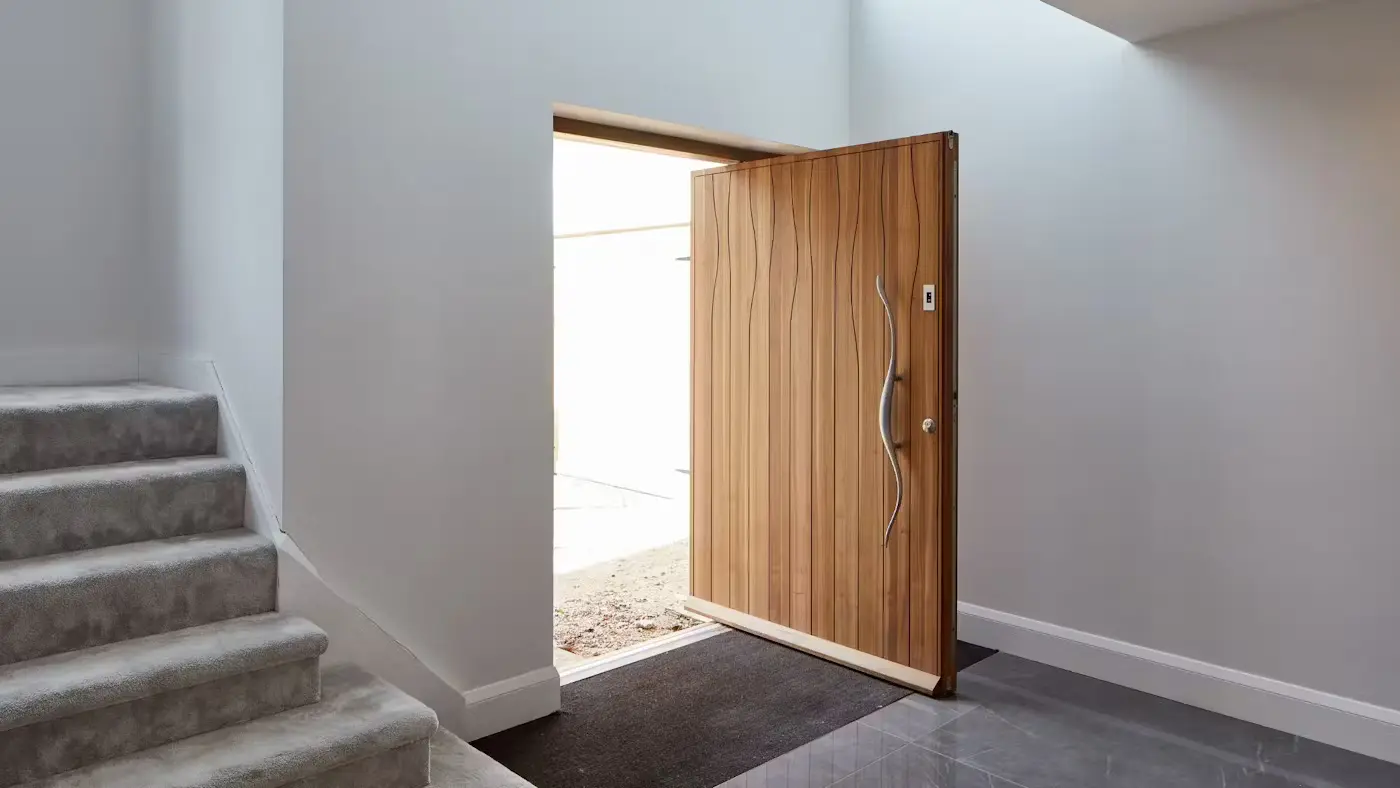
The Best Woods for Front Entry Door
When choosing the best wood for a front entry door, several types stand out for their beauty, durability, and overall performance. One of the top choices is oak, known for its strength and classic look. Oak has been used for centuries in furniture and building, making it a solid choice for a timeless, sturdy entry door. Let’s dive into why oak is a popular pick for entry doors and what to consider before deciding.
Oak: Strong and Classic Choice
Oak is one of the most popular choices for front entry doors. Its strength, natural beauty, and durability make it ideal for an entry door that can withstand the elements while adding a touch of elegance to your home’s exterior. Oak is a hardwood known for its dense grain, which gives it a visually striking appearance and enhances its structural integrity.
The wood is also easy to work with, allowing for intricate designs, custom carvings, or simple, clean lines, depending on your style. Whether for a traditional look or something more modern, oak adapts well to various finishes and suits multiple architectural styles.
Why Oak is a Top Pick for Entry Door?
Oak is often considered the gold standard for front entry doors, and for good reason. Here are a few key reasons why oak is such a popular choice:
- Strength and Durability: Oak is known for its toughness and resistance to wear and tear. When used for an entry door, it provides both long-term durability and reliable security. This makes oak an ideal option for a high-traffic area like your front door.
- Classic Appearance: Oak’s distinctive grain pattern and natural color make it a timeless choice. Whether you prefer the light, golden hue of white oak or the rich, reddish tones of red oak, it adds a sophisticated touch to any home. Oak doors are sure to remain stylish for years to come.
- Versatility in Design: Oak doors can be easily customized to fit various design preferences. You can opt for a simple, solid oak door with decorative panels, glass inserts, or carvings. This flexibility makes oak an excellent option for homeowners who want a personalized look.
- Resistance to Moisture and Insects: Oak is naturally resistant to moisture and insects, which helps prevent warping, rotting, or damage from pests. This makes it an excellent choice for areas with higher humidity or fluctuating temperatures.
Pros and Cons of Oak as a Front Door Material
While oak offers many benefits, it’s also important to consider the potential drawbacks before choosing it for your entry door. Here’s a closer look at the pros and cons of oak as a front door material:
Pros:
- Durability: Oak is a tough and long-lasting wood, perfect for an entry door that will endure the test of time. Its strength makes it an excellent option for both security and longevity.
- Aesthetic Appeal: Oak’s grain is visually appealing, adding character and warmth to your home’s exterior. The variety of tones, from light to dark, allows you to customize the look of your door to suit your home’s style.
- Maintenance: Oak has relatively low maintenance compared to some other woods. It can resist weather damage, fading, and moisture when properly sealed and finished.
- Energy Efficiency: Oak doors naturally provide good insulation, helping to keep your home comfortable and energy-efficient throughout the year.
Cons:
- Weight: Oak is a dense, heavy wood, making installation more challenging. However, the weight also adds to its sturdiness and durability.
- Cost: Oak tends to be more expensive than other woods, such as pine or fir. However, its durability and aesthetic appeal make it a worthy investment for many homeowners.
- Susceptibility to Scratches: While oak is a strong wood, its surface can be prone to scratching, especially in high-traffic areas. Regular maintenance, like refinishing or touch-ups, may be needed to keep the door looking its best.
- Expansion and Contraction: Like all wood, oak can expand and contract with changes in temperature and humidity. Ensure the door is properly sealed and maintained to prevent warping or cracking.
Mahogany: Luxury and Durability
Mahogany is a luxurious hardwood that has long been admired for its strength and beauty. It’s often the go-to choice for those who want to make a statement with their front entry door. Mahogany’s deep, reddish-brown color exudes elegance and adds a touch of sophistication to any home, making it perfect for grand entrances.
But Mahogany isn’t just about looks—it’s also highly durable. This wood is known for its resistance to the elements, so it’s often used for doors that withstand harsh weather conditions. Whether in a cold, rainy climate or experiencing summer heat, Mahogany holds up well, making it an excellent investment for your home.
Mahogany’s Superior Resistance to the Elements
One of the biggest advantages of Mahogany as an entry door material is its exceptional resistance to the elements. Mahogany can naturally resist moisture, which helps prevent warping, cracking, or swelling that can occur with other woods. This makes it ideal for areas with high humidity, rain, or fluctuating temperatures.
Additionally, Mahogany is known for its natural resistance to pests, such as termites, which can be a concern with other wood types. This added durability makes Mahogany an excellent choice for homes in regions where the weather can be unpredictable or where pests are a common issue.
Due to its dense structure, Mahogany also provides excellent insulation. This means that it not only stands up to the weather but also helps keep your home energy-efficient, reducing the need for heating and cooling.
How to Maintain Mahogany Doors for Long-Lasting Beauty?
While Mahogany is a strong and resilient wood, regular maintenance is key to ensuring it retains its stunning appearance and functionality. Here are a few simple tips to help you keep your Mahogany front entry door looking as beautiful as the day it was installed:
- Clean Regularly: Dirt, dust, and debris can accumulate on your door, causing scratches and dullness over time. Clean your Mahogany door regularly using a soft cloth and a mild soap solution. Avoid harsh chemicals that can damage the finish.
- Refinish the Door Periodically: To maintain the rich color of Mahogany, it’s essential to apply a fresh coat of finish every few years. This will protect the wood from UV damage and moisture, while keeping it glossy and vibrant. Choose a high-quality wood finish designed for outdoor use to ensure durability.
- Apply a Sealant: While Mahogany is naturally resistant to moisture, applying a protective sealant can enhance its resistance to water and the elements. This will help protect your door from the sun’s harsh rays and prevent fading over time.
- Inspect for Damage: Regularly check your Mahogany door for any signs of damage, such as cracks or chips. Small issues can often be repaired easily, but leaving them unchecked can lead to bigger problems.
- Avoid Direct Exposure to Sunlight: While Mahogany’s color is part of its charm, direct exposure to sunlight can cause it to fade over time. If your door gets a lot of sun, consider installing an awning or shade to help protect it from prolonged sun exposure.
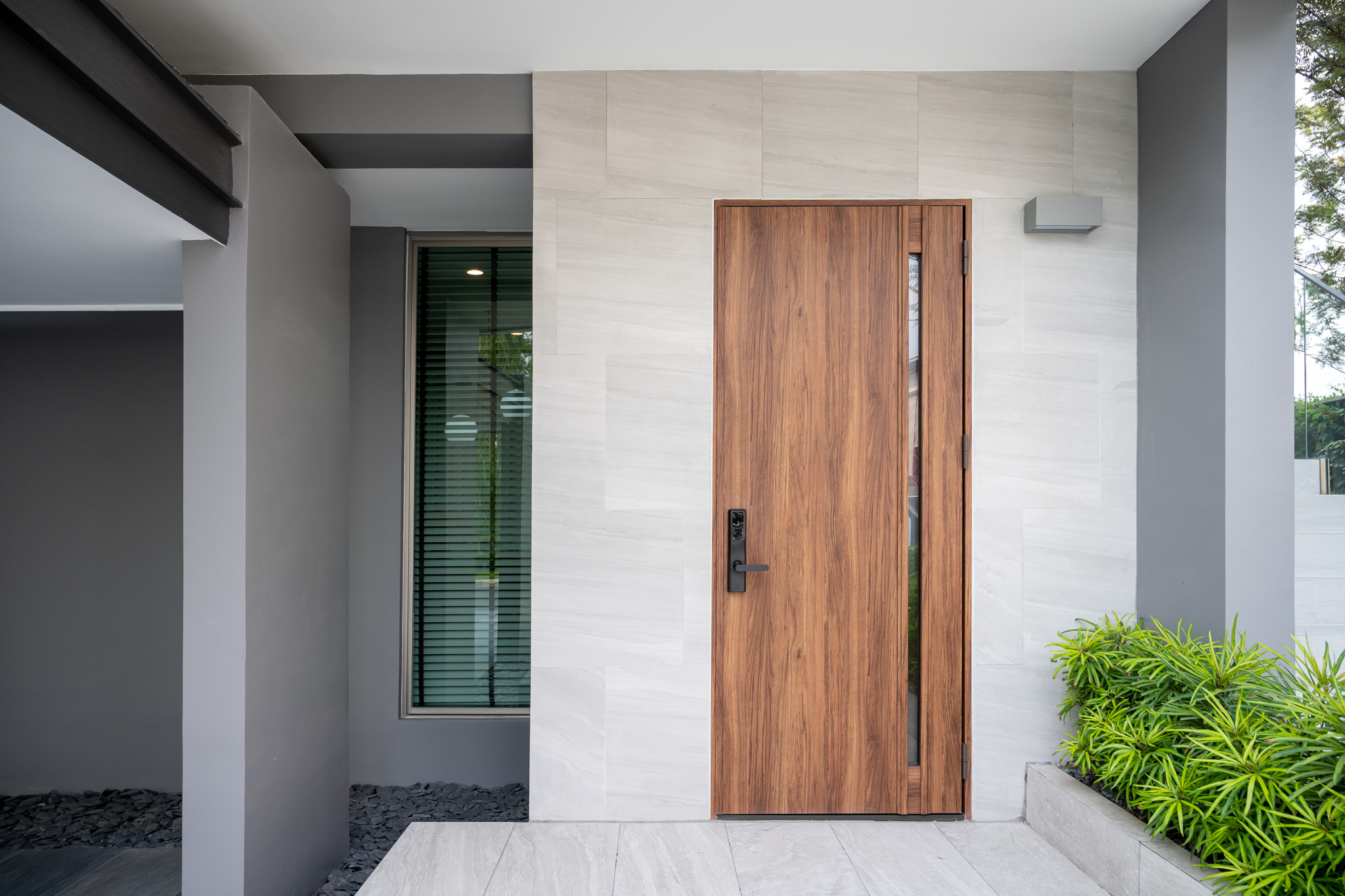
Maple: Affordable Yet Strong
Maple is one of the most popular hardwoods used for entry doors, especially for those on a budget. While it’s not as expensive as luxury options like Mahogany or Oak, maple still provides a sturdy and reliable material for a front entry door. Its affordability and strength make it an excellent choice for homeowners who want the benefits of a hardwood door without the high price tag.
The natural light color of maple gives it a fresh and modern look, making it a perfect choice for contemporary homes. Maple’s subtle grain pattern also adds a touch of elegance without overpowering the rest of the design. Whether building a new home or replacing an old one, a maple entry door can add value and appeal to your property.
Why Maple is a Great Budget-Friendly Option?
Maple is known for its budget-friendly price, which makes it an excellent option for homeowners who need a solid entry door but don’t want to break the bank. Compared to other hardwoods like oak or mahogany, maple tends to be more affordable, allowing you to achieve a high-quality, sturdy door without compromising on cost.
Despite its lower price, maple doesn’t sacrifice strength. It’s a dense wood, which means it’s durable and can handle the demands of daily use. Plus, maple’s natural resistance to wear and tear makes it ideal for an entry door with a lot of traffic.
Maple also has the added benefit of being easy to work with, making it a favorite for manufacturers and builders. This ease of customization allows you to find a maple door that perfectly fits your home’s style, whether you prefer a sleek, modern design or a more traditional look.
Durability and Finish Options for Maple Doors
While maple may be more affordable, it’s still a durable wood that can withstand time, especially when properly maintained. Its dense grain gives it natural resistance to dents and scratches, making it a good option for high-traffic areas like your front entry door. However, like any wood, it will benefit from protective treatments to keep it looking great for years.
Durability: Maple is a sturdy hardwood, which makes it resistant to damage from impact and heavy use. It can withstand the stresses of daily life, including bumps, knocks, and scrapes, while maintaining its integrity. Although it’s not as naturally moisture-resistant as Mahogany or Oak, maple can still hold up well when properly sealed and maintained.
Finish Options: One of the best things about maple is the variety of finishes available. Its light, pale color allows for versatility in staining or painting, so you can customize your door’s appearance to fit your style. Maple takes stain beautifully, showing off its grain without overwhelming the overall look. Whether you want a darker, rich hue or a light, airy finish, maple adapts well to a wide range of finishes. If you prefer a natural look, a clear finish will bring out its subtle grain and preserve its clean, fresh appearance.
Maple entry doors should be treated with a high-quality finish for added protection. Sealing the door helps protect it from moisture, dirt, and UV damage, ensuring its longevity. Regular maintenance, such as reapplying the finish every few years, will keep your maple door looking beautiful for a long time.
Fir: A Cost-Effective, Classic Wood
Fir is one of the most cost-effective woods available for entry doors, making it a popular option for those on a budget. It is a softwood, which makes it lighter than hardwoods like oak or mahogany, but still strong enough to serve as a reliable door material. Fir is widely available and easy to work with, making it an ideal choice for homeowners and builders looking for a practical and affordable wood option.
Its light color and straight grain give it a clean, classic look that works well with modern and traditional homes. Fir also has natural resistance to warping and cracking, especially when properly sealed and finished. This quality makes it an excellent option for areas with fluctuating weather conditions.
While Fir might not offer the same rich hues as hardwoods, it is versatile enough to accept a range of stains and finishes, allowing you to customize your entry door’s appearance to match your home’s style. Whether you want a natural, light finish or a deeper, more polished look, Fir can adapt to your design vision.
Why Fir is Often Chosen for Entry Door?
Fir is a go-to choice for many homeowners looking for a cost-effective option for their front entry door. Here’s why:
- Affordable and Accessible: Fir is relatively inexpensive compared to other woods like oak or walnut, making it an ideal choice for homeowners on a budget. It’s also readily available, so you won’t have trouble finding it in most markets.
- Strength and Durability: While Fir is a softwood, it still has the strength to handle daily wear and tear. With proper care, Fir doors can last for years without significant issues. It protects against physical impacts, such as bumps and scratches, which is important for an entry door.
- Good Workability: Fir is easy to work with, meaning it can be customized for intricate designs and carving, making it a favorite for custom-built doors. Fir can be shaped and molded whether you want a simple, sleek look or more detailed features.
- Weather Resistance: Although it’s a softwood, Fir has a natural resistance to moisture when treated correctly. It’s less likely to warp or swell when exposed to humidity compared to some other softwoods, making it a reliable option for homes in more humid climates.
How Fir Can Be Used for Various Door Styles?
Fir’s versatility in design makes it suitable for a wide variety of entry door styles. Whether you prefer a rustic, modern, or traditional look, Fir can be customized to match your vision. Here’s how Fir works for different door styles:
- Traditional Style Homes: Fir’s clean, straight grain and light color make it an excellent fit for traditional-style homes. You can opt for a classic, paneled Fir door with simple designs or go for something with a more intricate design. Fir accepts stains well, allowing you to enhance its appearance and match your home’s exterior.
- Rustic or Farmhouse Style Homes: Fir works perfectly for a rustic or farmhouse feel. Its light tones and natural texture complement rustic homes’ warm, inviting look. You can leave the Fir door in its natural state or add a weathered finish to give it an aged, authentic appearance.
- Modern and Contemporary Homes: Fir is often associated with traditional designs, but can also be used in modern settings. Its clean lines and ability to be stained or painted allow it to take on a sleek, contemporary look. Fir’s light color pairs well with modern aesthetics, especially with minimalist designs or glass panels.
- Custom Entry Doors: Fir is an excellent choice for custom-designed entry doors. Whether you want a custom shape, carvings, or decorative glass inserts, Fir’s ease of customization allows you to create a unique look. Its relatively low cost for custom work makes it a popular choice for personalized entry doors.
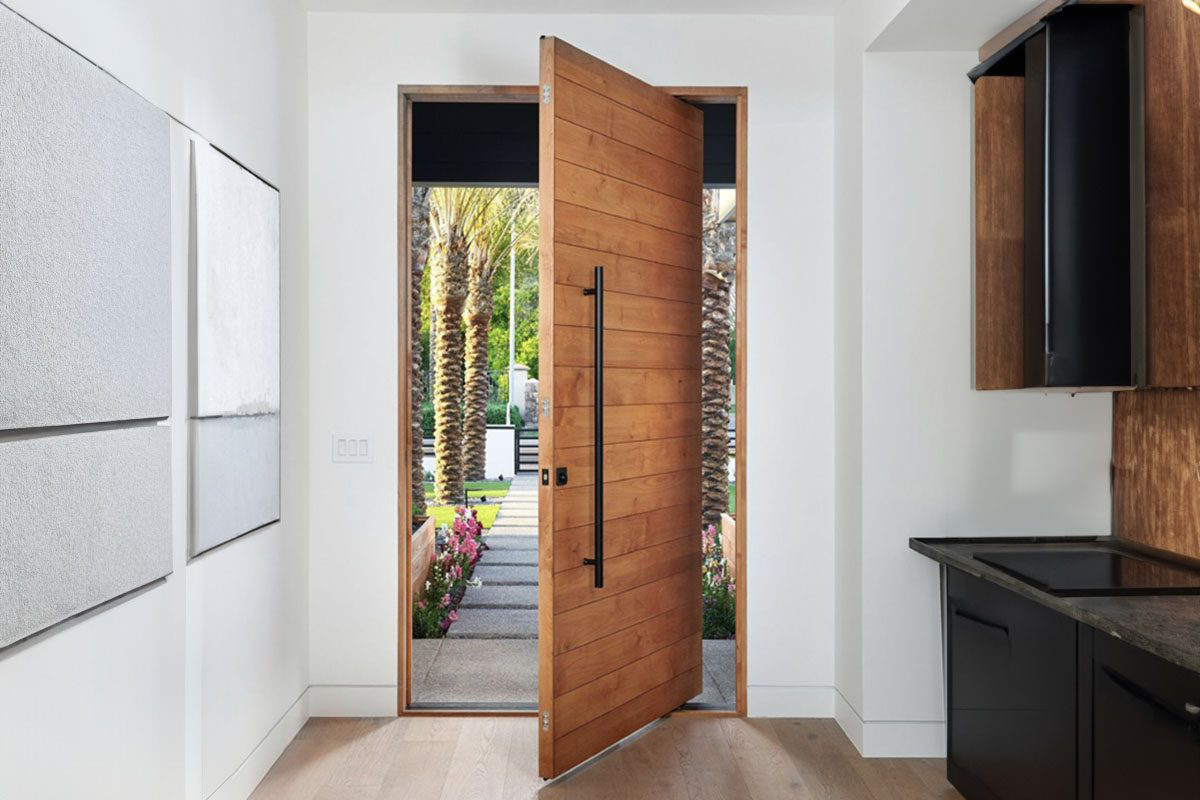
Maintenance Tips for Wood Front Entry Door
A wood front entry door is an investment that adds charm, warmth, and security to your home. However, regular maintenance is required to ensure your entry door looks beautiful and functions properly over the years. Although strong and durable, wood is susceptible to damage from the elements, dirt, and wear. With the right care, you can keep your wood entry door looking great for many years. Here are some essential maintenance tips for preserving your wood front door.
How to Protect Wood Doors from the Elements?
Wood entry doors are exposed to the elements, daily rain, snow, sun, and fluctuating temperatures can all take a toll. To protect your door from these harsh conditions, follow these steps:
- Seal the Door Properly: One of the most important steps in protecting your wood door is applying a high-quality sealant. A good sealant will create a protective barrier that keeps moisture out and prevents the door from warping or cracking. Look for a water-resistant, UV-protectant finish designed for outdoor use. Apply the sealant evenly across the entire door, paying close attention to areas around the edges and joints where moisture can seep in.
- Use a Storm Door: Adding a storm door can provide extra protection for your wood entry door. Storm doors act as a barrier against wind, rain, and snow, reducing the wear and tear on your main entry door. Plus, storm doors can help improve insulation, making your home more energy-efficient.
- Reapply Protective Coatings: Over time, protective coatings on your wood door can wear off due to exposure to sunlight and weather. It’s important to reapply these coatings every few years to ensure your door remains well-protected. Regular touch-ups can help maintain the wood’s appearance and prolong its life.
- Install an Overhang or Awning: If your door is exposed to harsh weather, consider installing an overhang or awning above it. This simple addition will provide shade and reduce direct exposure to rain and UV rays, extending the life of your door.
Re-staining or Refinishing: When and How
Over time, the finish on your wood front door can begin to fade, wear away, or show signs of damage. This is when re-staining or refinishing becomes necessary. Here’s how and when to do it:
When to Re-stain or Refinish:
- Fading or Discoloration: If you notice that the color of your door has faded or looks uneven, it’s time to re-stain or refinish. The finish on the door may have been worn down by the sun or weather, and re-staining will restore its original color and shine.
- Signs of Damage: Cracks, peeling, or flaking paint indicate that your door needs refinishing. These signs suggest the protective layer has been compromised, leaving the wood vulnerable to moisture damage and other issues.
- Every 2-3 Years: Even if your door doesn’t show visible signs of damage, it’s a good idea to re-stain or refinish your entry door every two to three years, especially if exposed to harsh weather conditions. This helps maintain the protective layer and enhances the door’s longevity.
How to Re-stain or Refinish:
- Prepare the Surface: Start by cleaning the door thoroughly. Use a mild soap solution to remove dirt, dust, and grime. If there’s peeling or old paint, gently sand the surface to smooth out any rough spots.
- Choose the Right Stain or Finish: When selecting a stain or finish, choose one made for exterior wood doors. A high-quality stain will penetrate the wood and provide both color and protection. If you’re refinishing, you may want to apply a new protective layer of varnish or polyurethane after staining.
- Apply Evenly: Use a brush or cloth to apply the stain or finish evenly across the door. Ensure to follow the grain of the wood and avoid over-applying the product. For a smooth finish, wipe off excess stain immediately after application.
- Allow Proper Drying Time: After applying the finish, allow it to dry completely before reattaching hardware or exposing the door to moisture. Drying time can vary depending on the product and weather, so follow the manufacturer’s instructions carefully.
Cleaning and Maintaining the Door’s Finish
Regular cleaning and maintenance are key to keeping your wood entry door looking like new. Here are some simple steps to care for the finish and keep your door looking polished:
- Dust and Wipe Regularly: Dust, dirt, and grime can accumulate on your door over time, so it’s important to clean it regularly. Use a soft cloth to wipe the surface and remove any debris gently. Use a mild soap solution and water for a deeper clean, but avoid harsh chemicals that can damage the wood’s finish.
- Polish for a Glossy Look: To restore your door’s shine, use a wood polish designed for exterior doors. Apply it sparingly with a soft cloth and buff the surface to a glossy finish. This will restore the door’s appearance and add a protective layer to help it resist dirt and moisture.
- Protect Against Scratches: Over time, your wood entry door may accumulate minor scratches or scuffs. To keep your door looking pristine, touch up these areas with a small amount of stain or finish to blend the repairs into the rest of the door. You may need to re-stain or refinish the entire door for deeper scratches or damage.
- Check for Gaps and Weatherstripping: Examine the door’s edges and seals for any gaps that could let in air or moisture. If you notice any wear on the weatherstripping, replace it to maintain the door’s energy efficiency and prevent drafts.
- Inspect Hardware Regularly: Don’t forget to check the hardware, such as hinges, handles, and locks. Clean them occasionally to remove dirt and lubricate them to ensure smooth operation. This will help prevent rust and keep your door functioning properly.
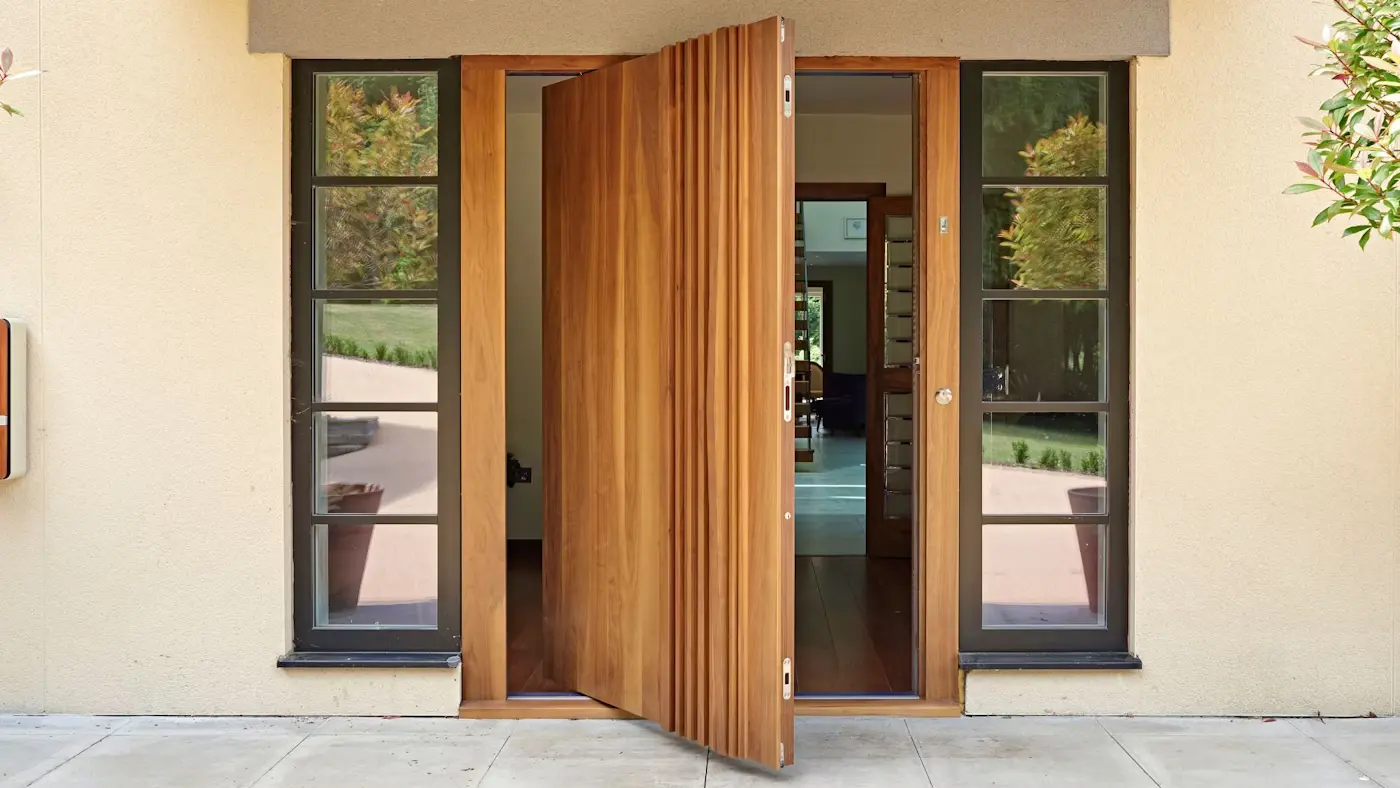
Final Thoughts
Choosing the right wood for your front entry door is about finding something that looks great and offers durability, security, and ease of maintenance. With so many wood options available, weighing the benefits of each type based on your budget, style preferences, and climate is important. Whether you opt for the classic beauty of oak, the luxurious appeal of mahogany, or the affordability of fir or maple, the right wood can enhance the look of your home while offering lasting performance.
Choosing the Best Wood for Your Front Door
When selecting the best wood for your entry door, there are a few key factors to consider. The first is durability—you want a wood that can withstand the elements and daily wear. If you live in a region with harsh weather conditions, a dense wood like mahogany or oak might be a good choice due to its natural resistance to moisture, UV rays, and pests. For a more budget-friendly option, fir or maple offer strong durability at a lower price point.
Aesthetic appeal is another important factor. The type of wood you choose can drastically affect your home’s curb appeal. For a rich, elegant look, mahogany provides deep, warm tones, while oak offers a more traditional and textured grain. On the other hand, Maple delivers a light, fresh look that suits modern and contemporary homes.
Lastly, budget considerations will play a large role in your decision. While hardwoods like mahogany and oak are more expensive, their durability and timeless appeal make them worthwhile investments. If you’re on a budget, fir and maple provide excellent performance without the high cost.
By considering these factors—durability, aesthetics, and cost—you can confidently choose the best wood for your front entry door that matches your needs and preferences.
Selecting the Right Finish and Hardware to Complement Your Door
Once you’ve chosen the perfect wood for your entry door, it’s time to consider finishing and hardware to complete the look. The right finish will enhance the natural beauty of the wood and protect it from the elements, ensuring it stays looking great for years to come.
In the end, you have several options. If you want to highlight the wood’s natural grain, consider a clear finish that lets the beauty of the wood shine through. A high-quality varnish or polyurethane will provide a protective coating that resists moisture and UV damage. If you prefer a darker look, you can opt for a stain that deepens the wood’s color while allowing the grain to show. A glossy finish will give your door a polished, elegant appearance, while a matte finish offers a more subtle, contemporary feel.
As for hardware, choose materials that complement the wood’s finish and overall style. For a rustic look, go for oil-rubbed bronze or matte black hardware. For more formal, traditional homes, brass or polished nickel hardware can add an elegant touch. Additionally, ensure that your hardware is durable and secure, as it is just as important as the door in providing safety and ease of use. Please pay attention to the lock, hinges, and handle quality to ensure they are built to last.
By carefully selecting the right finish and hardware, you can protect your wood entry door and enhance its overall look and functionality, creating a beautiful and secure entrance to your home.
Summary
In conclusion, choosing the right wood for your front entry door, along with the right finish and hardware, is crucial for creating a welcoming, durable, and stylish entrance to your home. With the right combination of materials, your entry door will provide security and improve your home’s curb appeal, offering long-lasting beauty and functionality for years to come.
Relate FAQ
What is the best wood for a front entry door?
Hardwoods like oak, mahogany, and cherry are the best woods for a front entry door. These materials offer durability, security, and aesthetic appeal, making them perfect for high-traffic areas and exposure to the elements.
Is mahogany a good choice for front doors?
Yes, mahogany is an excellent choice for entry doors. It is known for its rich color, durability, and resistance to the elements, making it ideal for exterior use. Mahogany also has a natural ability to resist warping, which makes it perfect for climates with fluctuating temperatures.
What are the pros and cons of using oak for a front door?
- Pros: Oak is strong, durable, and resistant to wear. It has a beautiful grain pattern that adds character to any home.
- Cons: Oak can be heavy and may require regular maintenance like staining or sealing to preserve its appearance, especially in high-moisture environments.
Can I use softwood like pine for a front entry door?
While softwoods like pine are more affordable and easier to work with, they may not offer the same durability and security as hardwoods. Pine doors can be susceptible to dents and scratches and may require additional treatments to withstand weather conditions.
How does wood affect the energy efficiency of front doors?
Wood can offer good insulation, especially when it is solid or has a thick core. The natural density of hardwoods like oak and mahogany helps keep energy costs down by maintaining indoor temperatures. However, proper sealing and insulation are crucial to maximizing energy efficiency.
What is the difference between solid wood and engineered wood for entry doors?
Solid wood doors are made from a single piece of timber, offering superior strength and durability. On the other hand, engineered wood is constructed from layers of wood, making it more stable and less likely to warp. Both options are popular for front doors, but engineered wood is often more affordable and resistant to environmental changes.
How do I maintain a wooden front door?
Regularly clean a wooden front door with a mild detergent and water to maintain it. Reapply a protective finish, such as varnish or paint, every few years to maintain its appearance and protect it from the elements. Additionally, check for any signs of warping or cracking and address them promptly.
Is teak a good option for front entry doors?
Teak is an excellent choice for front entry doors due to its natural oils, which make it resistant to moisture, rot, and insects. It has a beautiful golden-brown color and is highly durable, making it ideal for doors exposed to the elements.

